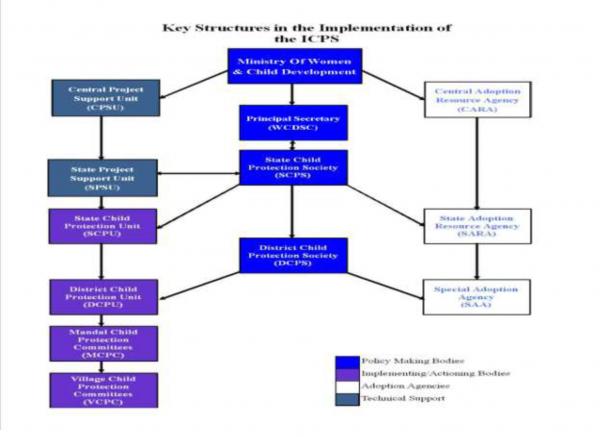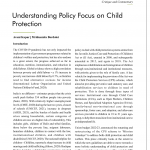
Bachpan Bachao : India’s Child Protection framework
28 November 2014
The issue of child protection has become especially relevant in recent times; many reports have highlighted the extent of child protection issues in India. Reports state that 12% of India’s children between the ages of 5 and 14 are illegally employed, around 50% are married before they turn 18, 50% face some form of sexual abuse, and a half of all girls between the ages of 10-13 are forced to drop out of school (HAQ, 2011; UNICEF, 2011). Criticism of child protection in India can be found in the HAQ report, which notes, “Despite India having the world’s highest number of malnourished children, sexually abused children and child labour, it is indeed sad that protection and health receive the least allocation and also have the maximum under-utilisation of scarce resources” (HAQ, 2010).
This blog seeks to give the reader a broad overview of how the child protection framework developed in India and where it stands now.
Child protection is defined as the prevention and response to violence, exploitation, and abuse against children, by creating an environment favourable for the overall development and protection of the child (UNICEF). In India, some of the important laws relating to child protection are the Juvenile Justice Act (2006), the Child Labour Act (1986), and the Prohibition of Child Marriage Act (2006). Further, the Indian government also began to raise the profile of child protection issues by developing the National Plan of Action for Children (2005) and passing the National Commission for the Protection of Children’s Rights Act (2005). The central government has borne the responsibility of developing legislation relating to child protection, while the state is expected to build a protective environment for children through policy, service provision, monitoring, and capacity building. Yet while legislation has been passed by the central government for years, no single ministry was made explicitly responsible for child protection issues–and no mechanism existed for the realisation of these rights–until 2006.
In 2006, the Ministry of Women & Child Development (MWCD) was given the status of an independent national ministry (prior to this, it was a department under the Ministry of Human Resource Development). This ministry became largely responsible for issues related to juvenile justice, adoption, and child protection. Once in operation, the MWCD explored the coordination of child protection services–and identified serious shortcomings and gaps in terms of infrastructure, schemes, and service. One review undertaken by the MWCD established that for child protection specifically, the amount was 0.034% of overall GOI expenditure on all departments for 2005-2006; this rose to only 0.06% in 2008-2009 (ICPS, 2009).
While the laws outlined above existed for the protection of children’s rights, these were poorly implemented; as a result, child protection remained low profile, and only weak, uncoordinated attempts to address protection issues were made. Estimates suggesting that around 170 million (40%) of India’s children were vulnerable to or experiencing difficult circumstances, along with figures such as those noted above, created an urgent case for increasing expenditure and addressing issues of child protection (ICPS, 2009). In an attempt to address this poor history of child protection and the shortcomings of the existing schemes, the Integrated Child Protection Scheme (ICPS) was developed.
The ICPS focuses on both Children in Need of Care and Protection (CNCP) and on Juveniles in Conflict with the Law (JCL). The ICPS takes the existing schemes and structures and incorporates them all under one umbrella in an attempt to create a comprehensive child protection programme capable of reaching children living in difficult circumstances.[1] Predominantly formed as the means to implement the Juvenile Justice Act, the ICPS aims to support and strengthen statutory structures existing under the act in order to facilitate their effective functioning. Launched nationwide in March 2009, the ICPS was intended to provide the nation with the structures needed to develop a protective environment for all children.
The following graph shows the key institutions involved in the implementation of the ICPS:

The scheme has now been running for the past 6 years. As per the WCD Annual Report 2012-13 significant progress has been made in establishing the statutory bodies. Upto March 2013, the scheme had catered to 75,052 children. When we compare this to the number of children who are in need of protection, this is less than 0.4% of the number of vulnerable children estimated by the Ministry of Women and Child Development themselves.
Low coverage and reach of this scheme, at least in part can be attributed to low budgetary allocations. When we compare allocations to the ICPS over the years as a percentage of the WCD allocations one finds that allocations to these schemes have been abysmally low.
| ICPS | WCD | ICPS as a % of WCD budget | |
| 2009-10 | 43 | 8556 | 0.5% |
| 2010-11 | 115 | 10688 | 1.1% |
| 2011-12 | 177 | 15671 | 1.1% |
| 2012-13 | 258 | 17036 | 1.5% |
| 2013-14 | 240 | 18286 | 1.3% |
| 2014-15 | 400 | 21194 | 1.9% |
Note: Till 2012-13, Numbers are actuals, 2013-14 are RE and 2014-15 are BE
Source: indiabudget.nic.in
With the new government coming in, the budgetary allocations have increased by 66 % over the previous year. Though still fairly low in terms of allocations, one can hope that Child Protection will be higher on the government’s priority list in the coming year.
References
- http://wcd.nic.in/publication/AR201213_english.pdf
- MWCD, “Integrated Child Protection Scheme,” New Delhi: Ministry of Women and Child Development (2009)
- HAQ, “Budget for Children 2004-05 to 2008-09,” HAQ Centre for Children’s Rights, New Dehli (2010)
- United Nations Children’s Fund (UNICEF) “Adolescence; An Age of Opportunity,” The State of the World’s Children 2011 (2011) New York.
- http://wcd.nic.in/icpsmon/pdf/icps/final_icps.pdf
- Indiabudget.nic.in
[1] The nine existing schemes and structures are Programme for Juvenile Justice, an Integrated Programme for street children, Childline service, Shishu Greh scheme, Scheme of working children in need of care and protection, Rajiv Gandhi National Creche Scheme for the Children of Working Mothers, Pilot Project to Combat the Trafficking of women and Children for Commercial Sexual Exploitation, Central Adoption resource Agency (CARA) & National Child Labour Project (NCLP)




